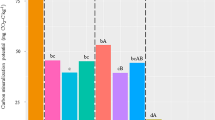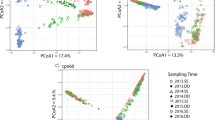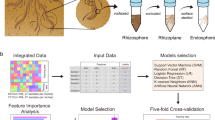Abstract
Although the influence of ozone (O3) on plants has been well studied in agroecosystems, little is known about the effect of elevated O3 (eO3) on soil microbial functional communities. Here, we used a comprehensive functional gene array (GeoChip 3.0) to investigate the functional composition, and structure of rhizosphere microbial communities of Yannong 19 (O3-sensitive) and Yangmai 16 (O3-relatively sensitive) wheat (Triticum aestivum L.) cultivars under eO3. Compared with ambient O3 (aO3), eO3 led to an increase in soil pH and total carbon (C) percentages in grain and straw of wheat plants, and reduced grain weight and soil dissolved organic carbon (DOC). Based on GeoChip hybridization signal intensities, although the overall functional structure of rhizosphere microbial communities did not significantly change by eO3 or cultivars, the results showed that the abundance of specific functional genes involved in C fixation and degradation, nitrogen (N) fixation, and sulfite reduction did significantly (P<0.05) alter in response to eO3 and/or wheat cultivars. Also, Yannong 19 appeared to harbor microbial functional communities in the rhizosphere more sensitive in response to eO3 than Yangmai 16. Additionally, canonical correspondence analysis suggested that the functional structure of microbial community involved in C cycling was largely shaped by soil and plant properties including pH, DOC, microbial biomass C, C/N ratio and grain weight. This study provides new insight into our understanding of the influence of eO3 and wheat cultivars on soil microbial communities.
Similar content being viewed by others
Log in or create a free account to read this content
Gain free access to this article, as well as selected content from this journal and more on nature.com
or
References
Aciego Pietri JC, Brookes PC . (2009). Substrate inputs and pH as factors controlling microbial biomass, activity and community structure in an arable soil. Soil Biol Biochem 41: 1396–1405.
Ainsworth EA . (2008). Rice production in a changing climate: a meta-analysis of responses to elevated carbon dioxide and elevated ozone concentration. Glob Change Biol 14: 1642–1650.
Andersen CP . (2003). Source–sink balance and carbon allocation below ground in plants exposed to ozone. New Phytol 157: 213–228.
Bais HP, Weir TL, Perry LG, Gilroy S, Vivanco JM . (2006). The role of root exudates in rhizoshpere interactions with plants and other organisms. Annu Rev Plant Biol 57: 233–266.
Barnes JD, Velissariou D, Davison AW, Holevas CD . (1990). Comparative ozone sensitivity of old and modern Greek cultivars of spring wheat. New Phytol 116: 707–714.
Betzelberger AM, Gillespie KM, McGrath JM, Koester RP, Nelson RL, Ainsworth EA . (2010). Effects of chronic elevated ozone concentration on antioxidant capacity, photosynthesis and seed yield of 10 soybean cultivars. Plant Cell Environ 33: 1569–1581.
Biswas DK, Xu H, Li YG, Sun JZ, Wang XZ, Han XG et al. (2008). Genotypic differences in leaf biochemical, physiological and growth responses to ozone in 20 winter wheat cultivars released over the past 60 years. Glob Change Biol 14: 46–59.
Booker F, Muntifering R, McGrath M, Burkey K, Decoteau D, Fiscus E et al. (2009). The ozone component of global change: potential effects on agricultural and horticultural plant yield, product quality and interactions with invasive species. J Integr Plant Biol 51: 337–351.
Cao J-L, Wang L, Zeng Q, Liang J, Tang H-Y, Xie Z-B et al. (2009). Characteristics of photosynthesis in wheat cultivars with different sensitivities to ozone under O3-free air concentration enrichment conditions. Acta Agron Sin 35: 1500–1507.
Chen Z, Wang X, Feng Z, Xiao Q, Duan X . (2009). Impact of elevated O3 on soil microbial community function under wheat crop. Water Air Soil Pollut 198: 189–198.
Chung H, Zak D, Lilleskov E . (2006) Fungal Community Composition and Metabolism Under Elevated CO2 and O3 . Springer Verlag GMBH: Germany, pp 143–154.
Dennis PG, Miller AJ, Hirsch PR . (2010). Are root exudates more important than other sources of rhizodeposits in structuring rhizosphere bacterial communities? FEMS Microbiol Ecol 72: 313–327.
Dixon P . (2003). VEGAN, a package of R functions for community ecology. J Veg Sci 14: 927–930.
Dohrmann AB, Tebbe CC . (2005). Effect of elevated tropospheric ozone on the structure of bacterial communities inhabiting the rhizosphere of herbaceous plants native to Germany. Appl Environ Microbiol 71: 7750–7758.
Doornbos RF, van Loon LC, Bakker PAH . (2012). Impact of root exudates and plant defense signaling on bacterial communities in the rhizosphere. A review. Agron Sustain Dev 32: 227–243.
Feng Z, Kobayashi K . (2009). Assessing the impacts of current and future concentrations of surface ozone on crop yield with meta-analysis. Atmos Environ 43: 1510–1519.
Feng Z, Kobayashi K, Ainsworth EA . (2008). Impact of elevated ozone concentration on growth, physiology, and yield of wheat (Triticum aestivum L.): a meta-analysis. Glob Change Biol 14: 2696–2708.
Feng Z-W, Jin M-H, Zhang F-Z, Huang Y-Z . (2003). Effects of ground-level ozone (O3) pollution on the yields of rice and winter wheat in the Yangtze River delta. J Environ Sci 15: 360–362.
Fierer N, Jackson RB . (2006). The diversity and biogeography of soil bacterial communities. Proc Natl Acad Sci USA 103: 626–631.
Haichar FZ, Marol C, Berge O, Rangel-Castro JI, Prosser JI, Balesdent J et al. (2008). Plant host habitat and root exudates shape soil bacterial community structure. ISME J 2: 1221–1230.
He Z, Deng Y, Van Nostrand JD, Tu Q, Xu M, Hemme CL et al. (2010a). GeoChip 3.0 as a high-throughput tool for analyzing microbial community composition, structure and functional activity. ISME J 4: 1167–1179.
He Z, Deng Y, Zhou J . (2012a). Development of functional gene microarrays for microbial community analysis. Curr Opin Biotechnol 23: 49–55.
He Z, Piceno Y, Deng Y, Xu M, Lu Z, DeSantis T et al. (2012b). The phylogenetic composition and structure of soil microbial communities shifts in response to elevated carbon dioxide. ISME J 6: 259–272.
He Z, Van Nostrand JD, Zhou J . (2012c). Applications of functional gene microarrays for profiling microbial communities. Curr Opin Biotechnol 23: 460–466.
He Z, Xu M, Deng Y, Kang S, Kellogg L, Wu L et al. (2010b). Metagenomic analysis reveals a marked divergence in the structure of belowground microbial communities at elevated CO2 . Ecol Lett 13: 564–575.
He Z, Zhou J . (2008). Empirical evaluation of a new method for calculating signal-to-noise ratio for microarray data analysis. Appl Environ Microbiol 74: 2957–2966.
Heath RL . (2008). Modification of the biochemical pathways of plants induced by ozone: what are the varied routes to change? Environ Pollut 155: 453–463.
Holmes WE, Zak DR, Pregitzer KS, King JS . (2006). Elevated CO2 and O3 alter soil nitrogen transformations beneath trembling aspen, paper birch, and sugar maple. Ecosystems 9: 1354–1363.
IPCC (2007) Intergovernmental Panel on Climate Change. Cambridge University Press: Cambridge.
Kanerva T, Palojärvi A, Rämö K, Manninen S . (2008). Changes in soil microbial community structure under elevated tropospheric O3 and CO2 . Soil Biol Biochem 40: 2502–2510.
Kasurinen A, Keinänen MM, Kaipainen S, Nilsson L-O, Vapaavuori E, Kontro MH et al. (2005). Below-ground responses of silver birch trees exposed to elevated CO2 and O3 levels during three growing seasons. Glob Change Biol 11: 1167–1179.
Larson J, Zak D, Sinsabaugh R . (2002). Extracellular enzyme activity beneath temperate trees growing under elevated carbon dioxide and ozone. Soil Sci Soc Am J 66: 1848–1856.
Leaphart AB, Lovell CR . (2001). Recovery and analysis of formyltetrahydrofolate synthetase gene sequences from natural populations of acetogenic bacteria. Appl Environ Microbiol 67: 1392–1395.
Li Q, Xu C, Liang W, Zhong S, Zheng X, Zhu J . (2009). Residue incorporation and N fertilization affect the response of soil nematodes to the elevated CO2 in a Chinese wheat field. Soil Biol Biochem 41: 1497–1503.
Liu L, King JS, Giardina CP . (2005). Effects of elevated concentrations of atmospheric CO2 and tropospheric O3 on leaf litter production and chemistry in trembling aspen and paper birch communities. Tree Physiol 25: 1511–1522.
Mazzola M, Funnell DL, Raaijmakers JM . (2004). Wheat cultivar-specific selection of 2,4-diacetylphloroglucinol-producing fluorescent Pseudomonas species from resident soil populations. Microb Ecol 48: 338–348.
Micallef SA, Shiaris MP, Colón-Carmona A . (2009). Influence of Arabidopsis thaliana accessions on rhizobacterial communities and natural variation in root exudates. J Exp Bot 60: 1729–1742.
Morgan PB, Ainsworth EA, Long SP . (2003). How does elevated ozone impact soybean? A meta-analysis of photosynthesis, growth and yield. Plant Cell Environ 26: 1317–1328.
Oksanen J, Blanchet FG, Kindt R, Legendre P, O’Hara RB, Simpson GL et al. (2010) vegan: Community Ecology Package.
Phillips RL, Zak DR, Holmes WE, White DC . (2002). Microbial community composition and function beneath temperate trees exposed to elevated atmospheric carbon dioxide and ozone. Oecologia 131: 236–244.
Pleijel H, Danielsson H, Gelang J, Sild E, Selldén G . (1998). Growth stage dependence of the grain yield response to ozone in spring wheat (Triticum aestivum L.). Agric Ecosyst Environ 70: 61–68.
Pleijel H, Eriksen AB, Danielsson H, Bondesson N, Selldén G . (2006). Differential ozone sensitivity in an old and a modern Swedish wheat cultivar - grain yield and quality, leaf chlorophyll and stomatal conductance. Environ Exp Bot 56: 63–71.
Rämö K, Kanerva T, Nikula S, Ojanperä K, Manninen S . (2006). Influences of elevated ozone and carbon dioxide in growth responses of lowland hay meadow mesocosms. Environ Pollut 144: 101–111.
Slaughter LH, Mulchi CL, Lee EH, Tuthill K . (1989). Chronic ozone stress effects on yield and grain quality of soft red winter wheat. Crop Sci 29: 1251–1255.
Soja G, Barnes JD, Posch M, Vandermeiren K, Pleijel H, Mills G . (2000). Phenological weighting of ozone exposures in the calculation of critical levels for wheat, bean and plantain. Environ Pollut 109: 517–524.
Schoene K, Franz JT, Masuch G . (2004). The effect of ozone on pollen development in Lolium perenne L. Environ Pollut 131: 347–354.
Shi S, Richardson AE, O’Callaghan M, DeAngelis KM, Jones EE, Stewart A et al. (2011). Effects of selected root exudate components on soil bacterial communities. FEMS Microbiol Ecol 77: 600–610.
Trivedi P, He Z, Van Nostrand JD, Albrigo G, Zhou J, Wang N . (2012). Huanglongbing alters the structure and functional diversity of microbial communities associated with citrus rhizosphere. ISME J 6: 363–383.
Wang H, Zhou L, Tang X . (2006). Ozone concentrations in rural regions of the Yangtze Delta in China. J Atmos Chem 54: 255–265.
Wittig VE, Ainsworth EA, Naidu SL, Karnosky DF, Long SP . (2009). Quantifying the impact of current and future tropospheric ozone on tree biomass, growth, physiology and biochemistry: a quantitative meta-analysis. Glob Change Biol 15: 396–424.
Wu L, Liu X, Schadt CW, Zhou J . (2006). Microarray-based analysis of subnanogram quantities of microbial community DNAs by using whole-community genome amplification. Appl Environ Microbiol 72: 4931–4941.
Xiong J, Wu L, Tu S, Van Nostrand JD, He Z, Zhou J et al. (2010). Microbial communities and functional genes associated with soil arsenic contamination and the rhizosphere of the arsenic-hyperaccumulating plant Pteris vittata L. Appl Environ Microbiol 76: 7277–7284.
Zak DR, Holmes WE, Pregitzer KS . (2007). Atmospheric CO2 and O3 alter the flow of 15N in developing forest ecosystems. Ecology 88: 2630–2639.
Zhou J, Bruns MA, Tiedje JM . (1996). DNA recovery from soils of diverse composition. Appl Environ Microbiol 62: 316–322.
Zhou J, Xue K, Xie J, Deng Y, Wu L, Cheng X et al. (2012). Microbial mediation of carbon-cycle feedbacks to climate warming. Nature Clim Change 2: 106–110.
Zhu X, Feng Z, Sun T, Liu X, Tang H, Zhu J et al. (2011). Effects of elevated ozone concentration on yield of four Chinese cultivars of winter wheat under fully open-air field conditions. Glob Change Biol 17: 2697–2706.
Acknowledgements
This research was supported by the Knowledge Innovation Project of the Chinese Academy of Sciences (KZCX2-YW-QN403 and KZCX2-EW-414), the International S&T Cooperation Program of China (Grant No. 2009DFA31110), and the Global Environment Research Fund by the Ministry of the Environment, Japan (Grant No. C-062), and by Oklahoma Applied Research Support (OARS), Oklahoma Center for the Advancement of Science and Technology (OCAST) through the Projects AR062-034 and AR11-035. The GeoChip development and associated computational pipelines used in this study were partially supported by the United States Department of Energy, Biological Systems Research on the Role of Microbial Communities in Carbon Cycling Program (DE-SC0004601).
Author information
Authors and Affiliations
Corresponding author
Ethics declarations
Competing interests
The authors declare no conflict of interest.
Additional information
Supplementary Information accompanies the paper on The ISME Journal website
Supplementary information
Rights and permissions
About this article
Cite this article
Li, X., Deng, Y., Li, Q. et al. Shifts of functional gene representation in wheat rhizosphere microbial communities under elevated ozone. ISME J 7, 660–671 (2013). https://doi.org/10.1038/ismej.2012.120
Received:
Revised:
Accepted:
Published:
Issue date:
DOI: https://doi.org/10.1038/ismej.2012.120
Keywords
This article is cited by
-
Fertilization altered co-occurrence patterns and microbial assembly process of ammonia-oxidizing microorganisms
Scientific Reports (2023)
-
Short-term elevated O3 exerts stronger effects on soil nitrification than does CO2, but jointly promotes soil denitrification
Plant and Soil (2023)
-
Effects of shining pondweed (Potamogeton lucens) on fungal communities in water and rhizosphere sediments in Nansi Lake, China
Community Ecology (2023)
-
Effects of shining pondweed (Potamogeton lucens) on bacterial communities in water and rhizosphere sediments in Nansi Lake, China
Environmental Science and Pollution Research (2022)
-
Saline–alkaline stress in growing maize seedlings is alleviated by Trichoderma asperellum through regulation of the soil environment
Scientific Reports (2021)



